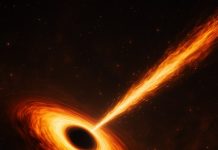
You’ve probably heard of black holes, right?
Those mysterious cosmic objects with gravity so strong that nothing, not even light, can escape them.
Supermassive black holes are even more intriguing: they can be billions of times heavier than our Sun!
And they usually reside at the center of galaxies, munching on matter from a spinning disk of gas and dust called an accretion disk. This activity creates powerful jets that glow brightly across the electromagnetic spectrum.
Well, astronomers have some exciting news: they’ve spotted not one, but two supermassive black holes orbiting each other in a galaxy named OJ287, about 5 billion light years away from us!
These findings were shared in the Monthly Notices of the Royal Astronomical Society.
OJ287, a quasar, or a super bright galaxy, has been under the watchful eyes of astronomers since 1888. They noticed that it had two distinct patterns of brightness that reoccurred roughly every 12 and 55 years.
They thought this might be because two black holes were dancing around each other in a cosmic waltz. The brighter periods, or flares, they speculated, happened when the smaller black hole took a daring dive through the accretion disk of the larger black hole. This dive heated up the disk’s material, causing it to glow intensely—a flare that was brighter than a trillion stars!
Researchers spent decades trying to predict when these flares would occur, with successful predictions and observations in several years, including 1983, 1994, 1995, 2005, 2007, 2015, and 2019.
However, they couldn’t directly observe the smaller black hole until recently during the 2021/2022 observational campaign.
In this special period, scientists successfully caught the smaller black hole in action, diving through the accretion disk of the larger one, causing a blue flash of light.
There were also some unexpected observations: unique types of flares and a burst of gamma rays (a type of high-energy light) when the smaller black hole passed through the disk. These surprises give researchers more clues about the behavior and properties of these fascinating objects.
Why have we missed these unique events before? Well, observing cosmic phenomena can be a bit like trying to catch a shooting star; you have to be looking in the right place at the right time. Sometimes, we’re just not lucky.
But this time, thanks to the tireless work of a team of astronomers, we got to witness these extraordinary cosmic events.
This discovery has made OJ287 the top candidate for being a pair of supermassive black holes that generate gravitational waves—ripples in the fabric of space-time.
These waves could potentially be detected in the future, providing even more evidence for the existence of this spectacular black hole duo. So, the dance of the black holes continues, and we are all eagerly watching their next moves.
Source: University of Turku.



